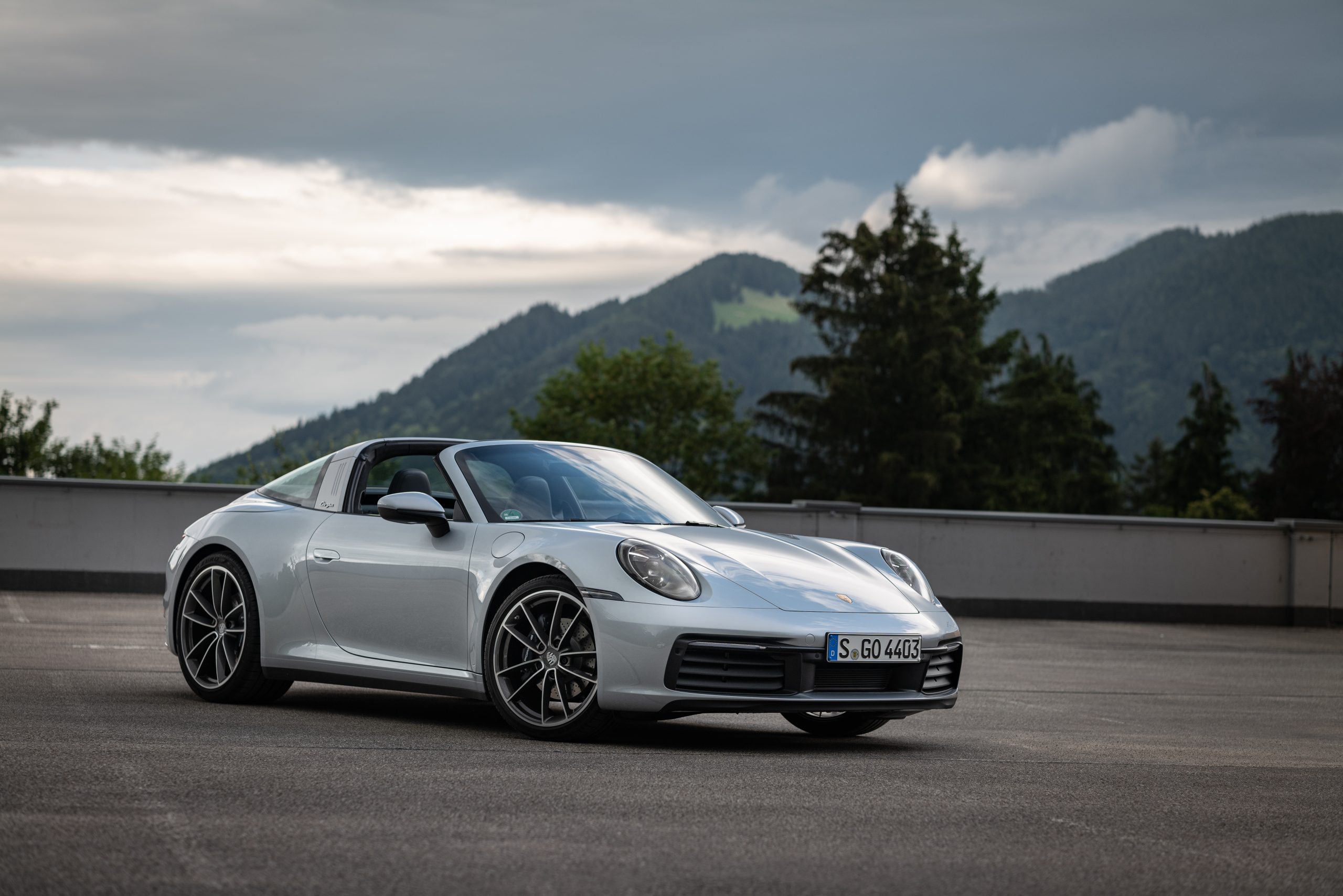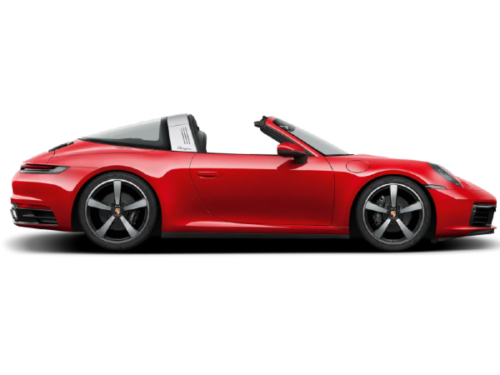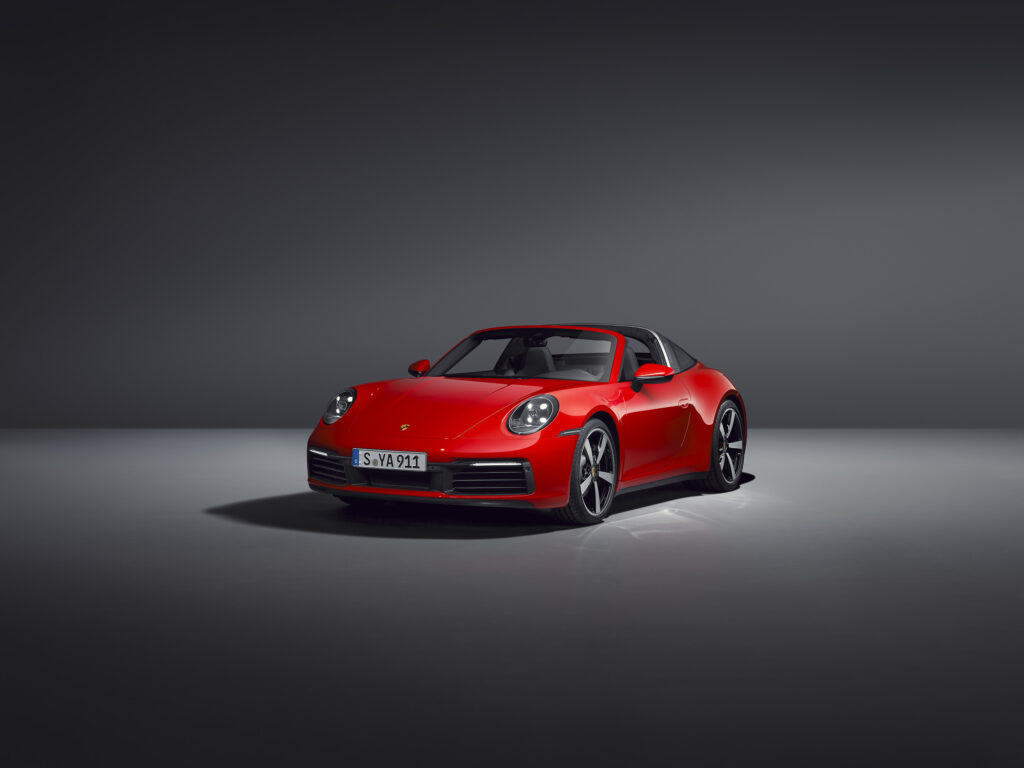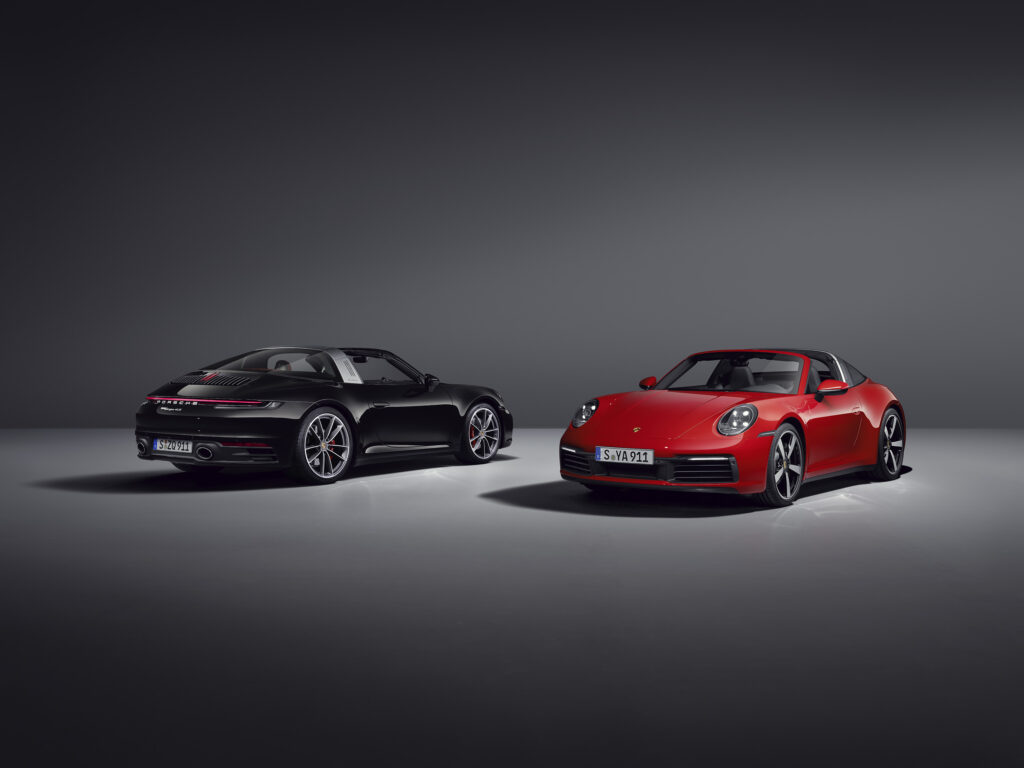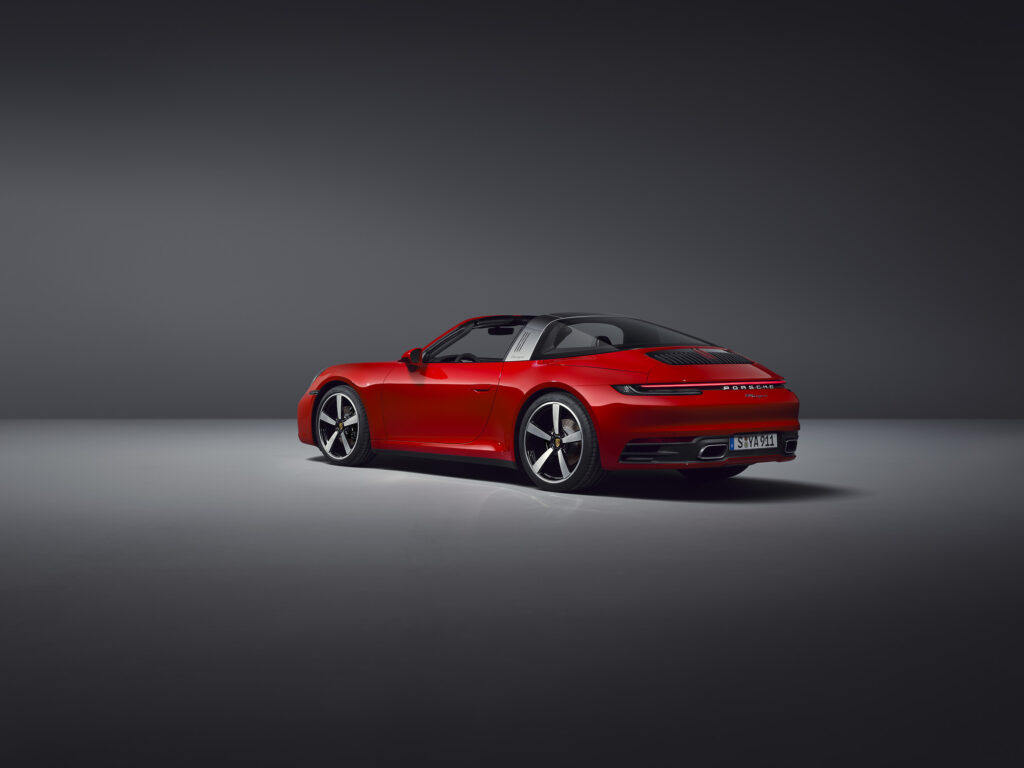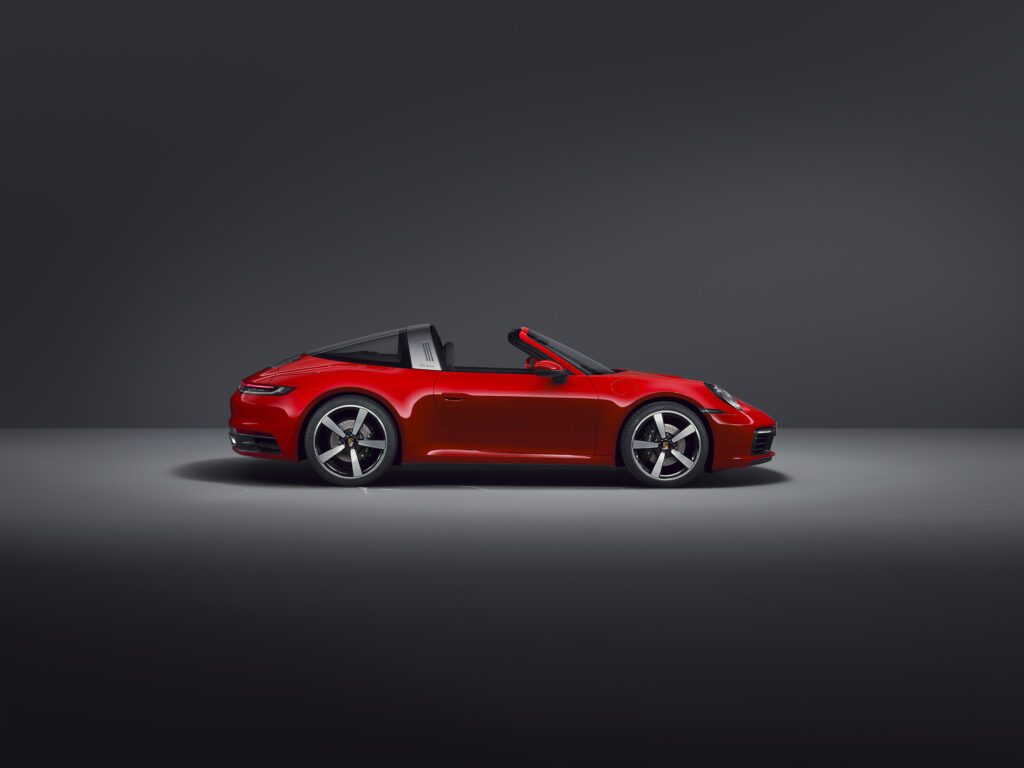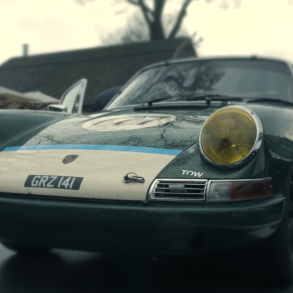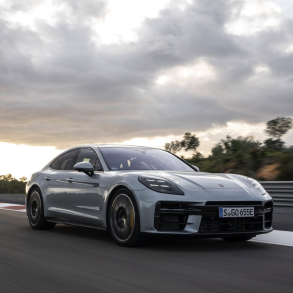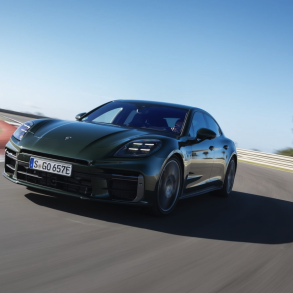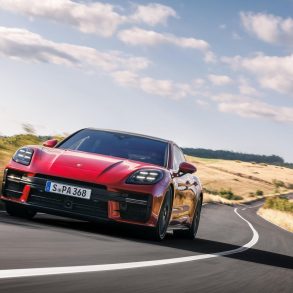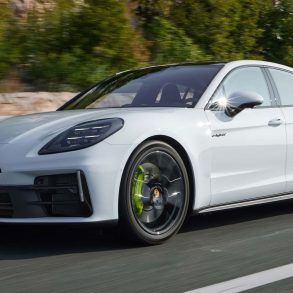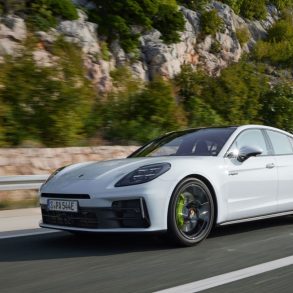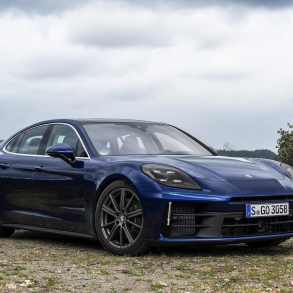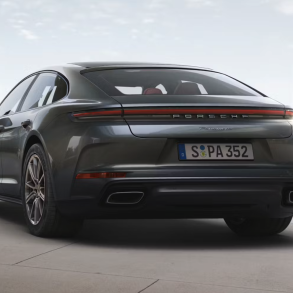2021 – 2024 Porsche 911 Targa 4 (992.1) – Reviews, Pricing, Specs & Buyers Guide
The 992.1 Porsche 911 Targa 4 is the connoisseur’s middle path between coupe and cabriolet: the classic Targa bar and wraparound rear glass for that unmistakable silhouette, a dramatic fully automatic roof ballet, and the all-season reassurance of Porsche Traction Management (PTM) all-wheel drive. Introduced for the 2021 model year and sold through 2024 (pre-facelift), the Targa 4 pairs the base 992 powertrain with the most characterful body style in the lineup. This guide covers the story, specs, tech, model-year changes, how it drives, what reviewers said, options worth hunting, and smart used-buyer tips.
Origins & Positioning
Porsche unveiled the 992-generation Targa 4 and Targa 4S in May 2020 as the third body style after coupe and cabriolet. The press release laid down the essentials: the Targa 4 produces 379 hp @ 6,500 rpm and 331 lb-ft from ~1,950–5,000 rpm from a 3.0-liter twin-turbo flat-six, driving all four wheels through the 8-speed PDK dual-clutch gearbox. With Sport Chrono, Porsche quoted 0–60 mph in 4.0 seconds and a 179-mph top track speed (the standard claim without SC is higher by a couple tenths). The Targa’s visual and mechanical signature is its spectacular roof. Just like the 1960s original, there’s a fixed Targa bar, a removable center roof section, and a wraparound rear window. In 992 form, it’s all motorized: open or close in ~19 seconds at the touch of a button, with the rear glass lifting as the fabric panel folds and stows—pure theater. A few model-line rules matter. All Targa models are AWD. The Targa 4 is PDK-only in 992.1, while the Targa 4S could be ordered with a seven-speed manual at no cost (bundled with Sport Chrono). If you want three pedals, you’re shopping a 4S; everyone else gets the ruthless competence of PDK.
The Targa name traces to the Sicilian Targa Florio road race. In 1965 Porsche responded to looming U.S. safety concerns about convertibles with a “safety cabriolet”—a fixed roll bar, removable roof panel, and a flexible rear screen that soon became glass. The concept stuck, evolving through glass-roof 993 and 996 eras before the 991 (2014) reintroduced the roll bar with the now-signature fully automated showpiece. The 992 refines that system and keeps the ritual—19 seconds from coupé-like to open-air.
Specs (Quick Reference)
- Engine: 3.0-L twin-turbo flat-six
- Output: 379 hp @ 6,500 rpm | 331 lb-ft @ 1,900–5,000 rpm
- Max engine speed: 7,500 rpm
- Transmission: 8-speed PDK (Targa 4); 7-MT available only on 4S
- Drivetrain: Active AWD (PTM)
- 0–60 mph: 4.2 s (factory) | 4.0 s with Sport Chrono
- Top speed: 179 mph
- Brakes: 330/330 mm iron rotors; PCCB optional
- Wheels/Tires (std): 19/20-in (235/40; 295/35). 20/21-in set optional
- Dimensions: L 177.9 in | W 72.9 in (w/o mirrors) | H ~51.1 in | WB 96.5 in
- Curb weight: 3,658 lb (PDK)
- Fuel tank: 17.6 gal
- Cargo: 4.66 cu-ft frunk + 5.75 cu-ft behind front seats (backrests folded)
Tech Highlights
- Porsche Wet Mode (standard): Acoustic sensors in the front wheel housings detect water spray and pre-condition stability/traction systems; the cluster prompts you to select Wet mode, which further calms throttle and torque distribution. It’s a meaningful advantage for a four-season Targa.
- PCM 6.0 infotainment (MY2022-on): Porsche’s January 2022 update brought a refreshed UI and Android Auto to compatible 911s (CarPlay was already supported). If smartphone integration matters, MY2022+ cars are desirable.
- Chassis suite: PASM adaptive dampers are standard; PTV+ (electronically controlled rear diff) is standard on Targa 4S PDK and optional on Targa 4. Wheel/tire stagger and braking hardware mirror the Carrera family—19/20-inch wheels standard on Targa 4, 20/21-inch standard on 4S (optional on 4).
How it Drives
Personality with polish. The Targa 4 drives like a Carrera 4 with a little extra vintage vibe—unruffled, torque-rich, and more about the savor than the stopwatch. The 3.0-liter TT flat-six spools quickly, the PDK is psychic, and PTM traction lets you deploy power early without corrupting steering feel. The structure is impressively stiff; wind management is excellent roof-open, and refinement with the roof closed is near-coupé. Reviewers consistently noted that the 992 Targa trades a whisper of dynamic edge for the experience—and for many buyers, that’s the point. Car and Driver called the 2021 Targa “bordering on spectacle”—praising the roof choreography and the everyday appeal—while reminding shoppers that the base Targa 4’s 379 hp is plenty.
Top Gear was even cheekier, dubbing it “the least dynamic, most flawed 911”—but still “a beltingly good sports car,” a knowing way of saying that on real roads, the deficit is tiny and the charm is huge. MotorTrend’s road test leaned into the evangelism: after decades of skepticism, they “finally understood” why people prefer a Targa—because it’s different, and the difference delights.
Model-Year Updates
- 2021 (launch year): Targa 4 and 4S join the 992 range. 379 hp / 331 lb-ft, PDK standard, AWD, 0–60 in 4.0 s with Sport Chrono (factory). The roof show remains: ~19-second open/close. Manual gearbox is available only on Targa 4S (with Sport Chrono).
- 2022: PCM 6.0 update adds Android Auto and a refreshed UI to compatible 911s. No core powertrain changes specific to Targa 4.
- 2023–2024: Running refinements and package shuffles; the core 992.1 Targa 4 recipe carries through to the MY2025-on refresh (outside the scope here).
- Special note (sibling): The Targa 4S Heritage Design Edition (limited) showcased retro colors, decals, corduroy, and unique trim—useful context for collectors even though it’s a 4S derivative.
Detailed specifications & hardware notes
Powertrain & driveline
- 3.0-liter twin-turbo flat-six (M9A family), direct injection, 10.2:1 compression; integrated dry-sump lubrication.
- PDK ratios: 4.89/3.17/2.15/1.56/1.18/0.94/0.76/0.61 with 3.39 rear axle ratio.
- AWD: Enhanced front-axle drive unit (water-cooled clutch housing; reinforced clutch discs) brings greater accuracy and load capacity versus prior gen.
Chassis & brakes
- Front MacPherson strut / rear multi-link; variable-ratio EPAS. With optional rear-axle steering the steering ratio quickens from ~14.1:1 on-center to 12.25:1 off-center; turning circle drops by ~1 ft.
- Brakes: 330 mm rotors front/rear with 4-piston fixed calipers (Targa 4). PCCB ceramics available (410/390 mm on S), valuable on repeated hard descents but overkill for most street use.
- Standard wheels/tires (Targa 4): 8.5J x 19 (235/40) front; 11.5J x 20 (295/35) rear. 20/21-inch set optional.
Body & practicality
-
Mixed-metal monocoque (steel, aluminum, magnesium); near-coupé refinement with the roof closed thanks to magnesium roof bows, multi-layer fabric, and heated rear glass. The frunk plus rear shelf (backrests folded) make weekender packing easy.
Reception & Reviews (Highlights)
- Car and Driver (first drive): Loved the spectacle and daily appeal; the Targa 4 “cranks out 379 hp and 331 lb-ft,” starting around $120k at launch—proof the base tune is potent and well-matched to the concept.
- Top Gear (HDE/4S context): “The least dynamic 911” but still “a beltingly good sports car”—journalist-speak for “yes, the numbers aren’t the ultimate, but you won’t care.”
- MotorTrend (road test): The penny drops: buyers pick Targa because it’s different—the vibe, the visibility, the ritual. That uniqueness is the value.
- MotorAuthority (first drive): Confirmed the effortless pace and the appeal of the Targa format in the 992 generation.
The consensus: the 992 Targa sacrifices a sliver of ultimate edge to add drama, heritage, and usability—and comes shockingly close to the coupe/cab on real roads.
Options & Packages that Matter
- Sport Chrono Package: Steering-wheel mode switch, performance displays, sharper mapping, and launch control (PDK). It’s also how Porsche gets to the quicker official 0–60 claim. Strongly recommended.
- PASM vs. PASM Sport: Standard PASM is superb on mixed roads; the lowered Sport tune suits smoother pavement and frequent canyon work.
- PCCB: Outstanding fade resistance and unsprung-mass savings; spectacular, but expensive to repair—iron discs are excellent for street use.
- Front-Axle Lift: Worth it for steep driveways or urban living.
- Targa roof colors & trim: The bar can be ordered in silver or black, and the roof module came in multiple colors—small details that matter for desirability and resale.
Buying Guide (Used)
- Roof system health. Cycle it fully—open/close (~19 s)—and listen for smooth, even motion and clean latching. Check seals after a wash. The mechanism is robust but complex; perfect behavior is table stakes.
- Transmission reality. In 992.1, Targa 4 is PDK-only; if you want a manual, a Targa 4S is your route (and brings Sport Chrono by default with the stick).
- Tires, wheels & alignment. The staggered setup (235/40 F, 295/35 R on 19/20s) can hide inner-shoulder wear on the rears; inspect inner barrels for rash and ask for alignment records—especially if the car has rear-steer or 20/21-inch wheels.
- Brakes. Iron rotors are durable; check for lip ridges and pedal pulsation. PCCB lasts ages on the street, but rotor damage is costly—inspect carefully.
- Wet-weather systems. Drive through spray; the cluster should suggest Wet Mode as the acoustic sensors detect water. Any warnings (or no prompt despite obvious spray) deserve a scan.
- Infotainment. If Android Auto matters, target MY2022+ or verify PCM 6.0. Porsche’s Jan-2022 update delivered both the UI and Android Auto capability on compatible cars.
- Provenance & options. Pull the build sheet or window sticker. Value-relevant boxes: Sport Chrono, rear-axle steering, PASM Sport, front-axle lift, PCCB, and desirable colors/roof/bar combinations. Heritage-inspired interior trims (even without the HDE package) add charm.
Ownership Experience & Verdict
The Targa 4 is an everyday special. Roof closed, it’s refined, quiet, and docile in PASM Normal. Roof open, the integrated wind deflector and rear glass shield passengers well at highway speed. The frunk + rear shelf setup is genuinely useful for weekender trips. In foul weather, PTM traction and Wet Mode turn the Targa into the 911 you actually reach for—more days of the year—which is precisely the point.
If the coupe is the purist’s blade and the cabriolet is the extrovert, the 992.1 Targa 4 is the romantic engineer’s choice—the one that makes opening the roof a ritual, wraps you in heritage, and still drives like a modern 911. It’s quick enough, polished everywhere, and unique in a way no other 992 body style is. Spec Sport Chrono, choose the wheel/tire and PASM tune that fits your roads, verify PCM 6.0 if you want Android Auto, and ensure the roof is perfect. Do that, and you’ll have the rare 911 that feels special at 5 mph or 150—every single time.
What We Said At Launch
The Targa 4’s main feature is its unique sunroof panel that allows you to enjoy this Porsche almost all year round. Add all-wheel drive and the sexiest design in the business, and this is the posers Porsche 911.
The Targa 4 gets the same powertrain as the base 911s, a twin-turbocharged 3.0-liter flat-six mated to Porsche’s bulletproof eight-speed dual-clutch transmission (7-speed manual is optional). Power comes out to 379 horsepower and 331 pound-feet of torque. Straight-line performance is in line with the base coupe and convertible. 0 – 60 mph takes just 4.0 second and the quarter-mile is 12.6 seconds. Top speed is a more than adequate 179 mph.
Even in lower-powered form, the 3.0-liter is a peach of an engine. Torquey across its rev range, it responds quickly to prods of the throttle, feeling like a larger-displacement naturally-aspirated engine than one being force-fed air. It lacks the ultimate zing of the 4S, both in thrust and noise.
The real problem with the Targa is the added weight and the structure. The structure trembles a touch more over high-frequency washboard, and the tremors are amplified through the steering column. With the top open and the wind deflector deployed from windscreen frame, there’s a bit of booming wind buffeting that occurs around 50 mph.
In the corners, the added mass is felt, with the Targa 4 feeling a little less confident when compared to the coupe or even the cabriolet. As a standalone car, it is great to drive, but when compared to its siblings, you can tell the difference.
Autoguide: …this Porsche packs more pounds than the Cabriolet, all to please your eyes in a way that model can’t. It’s no stiffer than the Cab, either, so dynamically it can’t match the purer coupe…what it loses in outright performance terms, it makes up for with a sense of occasion like no other 911.
The Targa’s top operates just as it did on the previous generation: The rear window cantilevers back as the top folds itself and tucks behind the rear seats, the glass then returning home on a 19-second round trip. On the previous Targa, it was possible to pop the top and smash that pricey piece of formed glassed into a brick wall or the Cayenne parked in the garage. In the newest generation, if the parking sensors detect any threats within 1.6 feet, the top will halt its disappearing act and alert the driver to the imminent danger. The Targa bar comes standard in silver and can be optioned in black. And be sure to keep this latest edition rubber side down or the two magnesium bars fitted to keep the targa panel taut would likely create a dazzling sparkler show.
While the base Targa isn’t the most dynamic 911, it will suit a certain buyer well. If you want the sexiest looking 911 that is a great all-rounder and you don’t plan on spanking it all the time, then this is a great 911 to buy.
Reviews & Videos
Pictures
Press Release
May 17, 2020
Porsche debuts the 2021 911 Targa 4 and 4S models
The design icon enters its eighth generation with more power and updated features
Atlanta, Georgia. Following the Coupe and Cabriolet, the third body style of the new 911 generation is now making its debut with the all-wheel drive 911 Targa 4 and 911 Targa 4S models. The innovative, fully automatic roof system remains its distinguishing feature, and just like the legendary original Targa model from 1965, it features a characteristic Targa bar, a retractable roof section above the front seats and a wraparound rear window. The roof can be automatically opened and closed in just 19 seconds at the touch of a button.
Both models are fitted with an eight-speed dual-clutch transmission (PDK) and intelligent all-wheel drive Porsche Traction Management (PTM) as standard to deliver compelling performance, traction and driving pleasure. Alternatively, the 911 Targa 4S can be ordered with a seven-speed manual transmission at no charge, which includes the Sport Chrono package as standard.
Both 911 Targa models are powered by a six-cylinder, three-liter twin-turbo boxer engine: the 911 Targa 4 now delivers 379 hp and accelerates from zero to 60 mph in just 4.0 seconds when equipped with PDK and the optional Sport Chrono Package – one tenth quicker than the previous model. The engine in the 911 Targa 4S puts out 443 hp and reaches the 60 mph mark in just 3.4 seconds with PDK and the optional Sport Chrono Package – four tenths quicker than its predecessor. The top track speed of the new 911 Targa 4 is 179 mph, while the 4S peaks at 188 mph.
Like on the 911 Carrera models, Porsche InnoDrive, which includes adaptive cruise control, is optionally available on PDK-equipped models for the first time. And thanks to the enhanced Smartlift function for the optional front axle lift system, frequently visited locations can be programmed so that the front end of the car is raised automatically when needed. The thorough array of options is supplemented by an extensive range of accessories from Porsche Tequipment and new personalization options from Porsche Exclusive Manufaktur. Additionally, Porsche will expand the combination of traditional styling elements, timeless design and cutting-edge technology in a special edition of the 911 Targa, which will make its debut in June.
Powerful twin-turbo boxer engines
Like the 911 Carrera models, both 911 Targa variants profit from an increase in power compared to the previous generation of three-liter twin-turbo six-cylinder boxer engines. The engine in the 911 Targa 4 produces 379 hp at 6,500 rpm, which is nine hp more than its predecessor. Its maximum torque of 331 lb-ft is delivered across a wide engine speed range from 1,950 to 5,000 rpm. Making 443 hp, the 911 Targa 4S delivers 23 hp more than the previous model and generates 390 lb-ft of torque (22 more than before) between 2,300 and 5,000 rpm.
Optimized all-wheel drive for even better traction
The enhanced performance of the new all-wheel drive models goes hand-in-hand with further development of the front-axle drive system that was already introduced in the 2020 911 Carrera 4 and 4S Coupe and Cabriolet models. The clutch and differential unit is water-cooled and has reinforced clutch discs for greater strength and a higher load capacity. The increased actuating torque at the clutch improves its adjustment accuracy and the function of the front-axle drive. Overall, the enhanced front-axle drive with Porsche Traction Management (PTM) contributes to even better traction in all road conditions.
Further developed chassis for increased comfort and sharper handling
Like on all Porsche 911 Carrera models, the electronically-controlled variable damping Porsche Active Suspension Management (PASM) system is standard equipment on the new 911 Targa models. This system automatically adjusts the damping characteristics focused on maximizing driving comfort and handling to each driving situation, and has two modes that can be activated by the touch of a button: Normal and Sport. Porsche Torque Vectoring Plus (PTV Plus), which includes an electronic rear limited slip differential with fully variable torque distribution, is standard for the Targa 4S with PDK and is available as an option on the Targa 4. When ordered with the manual transmission, the 911 Targa 4S comes fitted with a mechanical rear limited slip differential. Like the other eighth generation Porsche 911 variants, the Targa models are also equipped with Porsche Wet Mode as standard. Sensors fitted in the front wheel housings are capable of detecting water on the road surface and, if significant volumes of water are picked up, the stability control system is automatically optimized for wet conditions, and a message in the instrument cluster provides a recommendation for the driver to manually switch to Wet Mode. Once the driver does so, the powertrain is then adapted to the conditions to help improve traction and stability in adverse weather conditions.
Like the 379 hp 911 Carrera models, the 911 Targa 4 comes standard with 235/40 ZR tires on 19-inch alloy wheels in front and 295/35 ZR tires on 20-inch wheels in the rear. The 4S model is fitted as standard with 245/35 ZR tires on 20-inch front wheels and 305/30 ZR tires on 21-inch rears – this larger wheel combination is optional for the 911 Targa 4. On the Targa 4, the standard cast iron rotors measure 330 millimeters in diameter front and rear and use black four-piston monobloc fixed calipers. The redpainted brake calipers on the Targa 4S have six pistons at the front axle, four at the rear, while its rotors measure 350 mm front and rear. The Porsche Ceramic Composite Brake (PCCB) can be ordered as an option for both models.
Extravagant Targa design with a modern interpretation
The most striking feature of the 911 Targa is of course its Targa bar and roof, which was adopted from the previous 991 generation model and optimized further. Harking back to classic Targa models of the 1960s and 1970s, the Targa bar comes standard in silver but can also be optionally ordered in black, and features the characteristic “Targa” model designation on each side, which has graced 911 Targa models since 1965. The roof construction consists of two flat magnesium elements, which hold the fabric roof in place securely and contribute to the elegant silhouette of the car. A heated glass rear window, sound-deadening material inside the fabric, as well as an extendable wind deflector integrated into the upper cowl frame of the windshield make the new 911 Targa comfortable and suitable for daily use.
The exterior of the 911 Targa is characterized by the design elements of its 992-model generation. Compared to its predecessors, its body features significantly more pronounced wheel housings at the front and, between its LED headlights, its front luggage compartment lid has a distinctive recess evoking the design of earlier 911 generations. The rear is characterized by a wider, variably extending rear spoiler and a seamlessly integrated and elegant light bar. With the exception of the front and rear fasciae, the entire outer skin is made from aluminum. The interior echoes the 911 Carrera models and is characterized by the clear and straight lines of its dashboard and its recessed instruments. The 911 models from the 1970s provided the inspiration here. Alongside the central tachometer – very much a defining feature for Porsche – two thin, frameless freeform displays offer key vehicle information for the driver. Five toggle switches providing direct access to important vehicle functions are located below the 10.9-inch center screen of the Porsche Communication Management (PCM). The standard PCM features include online navigation as well as Connect Plus (A subscription is required after an initial 12-month trial period).
The model for a new class of sports cars since 1965
The 1965 911 Targa 2.0 was a trailblazer for a completely new type of car. Originally marketed as a “safety cabriolet with supplemental roll bar”, the Targa, with its removable roof section, soon established itself as an independent concept and became a style icon. Right up to the present day, Porsche has continued to combine two worlds in the 911 Targa: the advantages of open-top driving in a cabriolet combined with the everyday comfort and interior feeling of a coupe.
Pricing and availability
The new 2021 911 Targa models are available to order now and are expected to reach U.S. dealers in late 2020. MSRP is $119,300 for the 2021 911 Targa 4 and $135,200 for the 2021 911 Targa 4S, not including a $1,350 delivery, processing and handling fee


